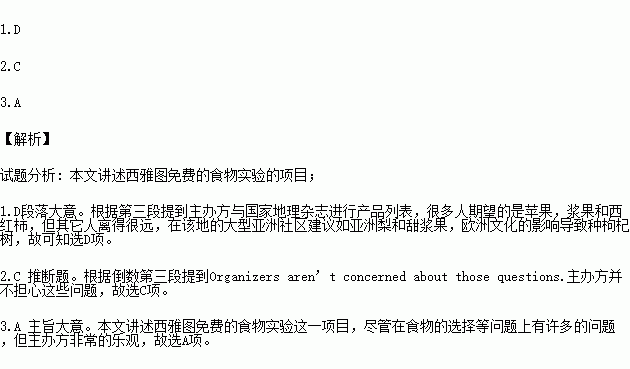题目内容
Can food be free, fresh and easily accessible? That’s the bold (大胆) question that the city of Seattle is hoping to answer with a new experimental farm not far from the city’s downtown area that will have fruits and vegetables for anyone to harvest this fall.
On Beacon Hill, just south of central Seattle, landscape developers and a few affordable-food advocates are building an eatable food forest. Everything grown in the area will be eatable. And it’ll be open around the clock to anyone who wants to come and pick some fresh blueberries or pears.
Organizers shared with National Geographic a list of the crop offerings. Many are expected: apples, berries and tomatoes. But others are pretty far-out. A large Asian community in the area suggested things like Asian pears and honeyberries. A European influence led to the planting of medlar trees.
The concept is modeled on permaculture, a design system and school of thought emphasizing the use of renewable nature resources and the enrichment of local ecosystems. Offering people free, fresh food is one motivation, but making the land useful and ecologically enriched is the larger goal.
That being said, some potential problems come to mind. What if all of one fruit is gone the first weekend when it’s ripe? What if people pick things too early and spoil the potential for everyone?
Organizers aren’t concerned about those questions. “We’ve had many discussions about what would happen if someone comes and picks all the blueberries,” says Margarett Harrison, the landscape architect designing the project.” But that’s been considered as a good thing. We’ll just plant more.”
Anything related to agriculture and good food — in large quantities — takes time. Most of the trees won’t be mature enough for a few more years. But a few decades could make the area impressively productive.
Idealistic? Perhaps. But it’s the kind of idealism that anyone who likes to eat fresh things from time to time can get behind. And that’s the type of motivation that organizers hope will keep going.
1. Paragraph 3 is mainly about _______.
A. the crops that will be harvested this fall
B. people’s attitude towards the project
C. which communities live in the area
D. how the food selection was made
2.What’s Margarett Hrrison’s attitude towards the potential problems the forest may face?
A. Concerned. B. Cautious.
C. Optimistic. D. Uninterested
3.The text is mainly about ______.
A. Seattle’s free food experiment
B. what the future of forests will be
C. agricultural development in Seattle
D. how to keep in harmony with nature
 每日10分钟口算心算速算天天练系列答案
每日10分钟口算心算速算天天练系列答案
